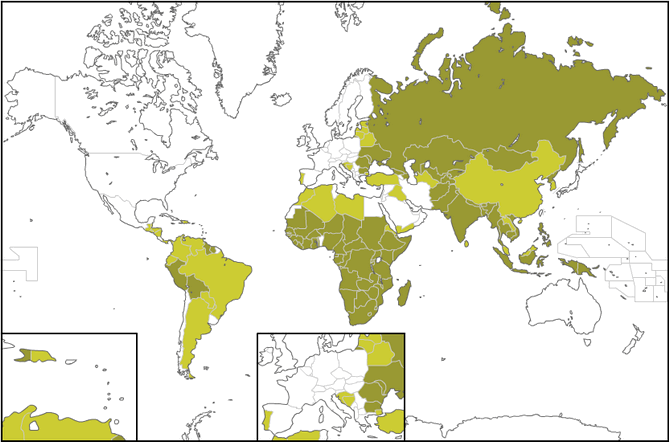Team:TUDelft/Project
From 2012.igem.org
| Line 16: | Line 16: | ||
<br/> | <br/> | ||
| - | <p>At the map below you can see the countries suffering from Tuberculosis. According to <a href="http://www.vaccinatiesopreis.nl">www.vaccinatiesopreis.nl</a> the dark green refers to many | + | <p>At the map below you can see the countries suffering from Tuberculosis. According to <a href="http://www.vaccinatiesopreis.nl">www.vaccinatiesopreis.nl</a> the dark green refers to many cases of TB, the light green to less and the white too a few cases.</p> |
<div style="position:relative; align:center; top:0; left:0; width:580px; height:240px; border:0; margin:0 0 20px 0; padding:0; "> | <div style="position:relative; align:center; top:0; left:0; width:580px; height:240px; border:0; margin:0 0 20px 0; padding:0; "> | ||
<a href="https://static.igem.org/mediawiki/igem.org/4/4a/TBmap.gif" rel="lightbox" title="Tuberculosismap"> | <a href="https://static.igem.org/mediawiki/igem.org/4/4a/TBmap.gif" rel="lightbox" title="Tuberculosismap"> | ||
Revision as of 11:17, 13 July 2012
Snifferomyces - A Tuberculosis Screening Automaton
What is the use of technology, if it cannot contribute to improving human life? With this thought in mind, the TU Delft 2012 iGEM team, composed of students from the life sciences, bioinformatics, applied physics, aerospace, mechanical and chemical engineering disciplines decided to use the platform of synthetic biology, addressing a real challenge affecting millions of people .
Inspired by the sniffer rats trained to smell the presence of tuberculosis, the team decided to build an autonomous olfactory system to detect volatile compounds, by re-inventing man's oldest industrial microorganism, yeast, to provide for a non-invasive, rapid and cost-effective diagnosis system for tuberculosis.
The problem
Lack of diagnostic capacity has been a crucial barrier preventing an effective response to the challenges of Tuberculosis (TB). It is second only to HIV/AIDS as the greatest killer worldwide due to a single infectious agent. In 2010, 8.8 million people fell ill with TB and 1.4 million died from it. Over 95% of TB deaths occur in low -and middle- income countries where, standard TB diagnostic tools, that need to be used in a lab setting, pose major barriers for screening. This happens due to the costs and the time involved in the process.
(according to World Health Organization)
At the map below you can see the countries suffering from Tuberculosis. According to www.vaccinatiesopreis.nl the dark green refers to many cases of TB, the light green to less and the white too a few cases.
The Approach
We approach this challenge by designing an olfactory device, that will detect specific volatile compounds. By this project we introduce olfactory receptor gene fusions into Saccharomyces cerevisiae and link this to a physiological response easy to see with naked eye. We divide the project into two subcategories
- A diagnosis system for the presence of tuberculosis bacteria in the lungs via sensing of chemical compound methyl nicotinate by S. cerevisiae. For diagnostics, the response to these molecules is light, generated by either Lux proteins (visible blue light) or GFP (fluorescent green).
- A generic toolkit, allowing scientists to introduce their own olfactory receptors in yeast with minimal effort for the detection of other volatile compounds.
The olfactory system also showcases how an organism as ancient as yeast, with its rich tradition in industrial microbiology can be used, with a little innovation, in designing autonomous systems which can contribute in an extraordinary way for the betterment of society.
 "
"
